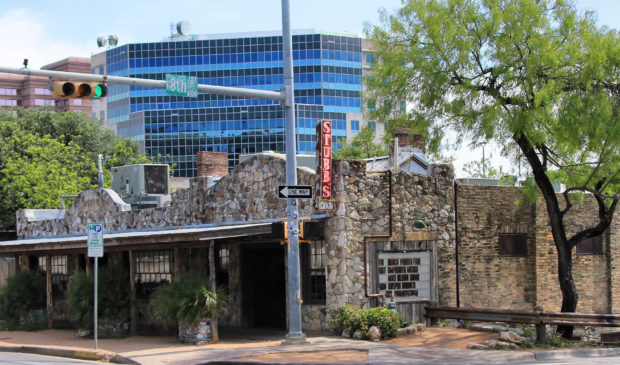Study: Red River music venues face ‘11th hour’ endangerment
Friday, April 21, 2017 by
Chad Swiatecki A key piece of Austin’s live music scene is at a crisis point and at risk of disappearing in the coming years if dramatic action isn’t taken soon. Those are the findings included in a nearly complete report by the Urban Land Institute following its study of the economic viability of the city’s Red River Cultural District.
The report, titled “Red River Cultural District: Live Music Preservation,” was obtained by the Austin Monitor ahead of its mid-May completion date, though city officials confirmed the nature of its findings and recommendations. The so-called “technical assistance panel” gathered data and conducted interviews with music venue owners and other stakeholders in the 13 music venues clustered on Red River Street between Sixth and 12th streets in late 2016.
Painting a picture of the development pressures, safety concerns and thin profit margins facing club owners, the study’s conclusions say, “Austin is in the effective ‘11th hour’ of the endangerment of the live music scene, and taking no action in the near term and failing to sustain action over the long haul are not acceptable options.”
Calling live music venues – specifically those in the Red River Cultural District – “a vital part of Austin’s identity,” the document lists a series of short-, mid- and long-term recommendations for public officials and the business community to undertake to preserve clubs such as Mohawk, Beerland, Cheer Up Charlies and others that incubate local acts most nights.
Public officials have shown growing concern in recent years that large-scale development projects such as the Waller Creek Conservancy and creation of the Dell Medical School could invite more development or provoke rent increases that force small music venues nearby out of business.
The 20 recommendations include some that would require unorthodox actions by Austin’s public and private leaders. Among them: creation of a citywide music venue preservation program that could conceivably be paid for with some mix of “tax abatements, modification of alcohol taxes, 380 (incentive) agreements, the sharing of hotel occupancy taxes normally allocated to The Arts.”
Other suggestions – such as allowing later outdoor music on a trial basis so that clubs with outdoor stages can make more alcohol revenue, or moving forward with the “agent of change” policy meant to reduce noise level conflicts between venues and nearby residential uses – are already moving toward enactment.
Other recommendations:
– Increase safety throughout the district
– Get venues more involved in local music and other organizations
– Create a best practices cooperative among venues to increase economic efficiency
– Encourage venues to “self-police” and identify bad actors in their ranks
– Participate in CodeNEXT discussions that could streamline permitting processes for venues
– Find a leader in the private sector to push the policy and preservation agenda
– Partner with the Waller Creek Conservancy to encourage utilization of music venues by visitors to nearby parks
– Make the Red River Cultural District eligible for funding for more infrastructure and police resource improvements
– Explore public/private agreements for venue preservation, including an already speculated-about “strike fund” to purchase and protect venue properties
– Access more funds from specially structured public funding sources such as Tax Increment Reinvestment Zones
– Improve the district’s streetscape to encourage daytime use
– Find a permanent solution to the growing homeless population outside the Austin Resource Center for the Homeless
– Encourage music tourism and architectural tourism of the district’s historic structures
The study, which was commissioned by the Red River Cultural District Merchants Association, was expected to be complete in a matter of weeks, and its creators are still determining how it will be rolled out and possibly utilized to create momentum on enacting solutions.
Nicole Klepadlo, project manager for the Soul-y Austin merchant association incubator program, said a series of presentations and possible creation of a task force for the district are possible next steps.
“We want the merchants to be in the lead of the discussion, and having the expertise of (the Urban Land Institute) helped us get an external lens on what’s happening there because of their experience in the private sector,” she said. “There’s a lot of energy around the music industry and the Red River Cultural District as a whole right now, and this is a big puzzle piece with respect to everything that’s going on in the eastern part of downtown.”
The health of Austin’s music scene in general has received much attention in recent years, especially following the release of the city’s 2015 music census, which found that Austin musicians are being squeezed out of the city economically. Venue health was another element of concern since many full-time music venues – and virtually all of those in the Red River Cultural District – operate only in the evenings and have a small window of time to generate revenue.
Mayor Steve Adler has worked to create discussion on those issues and to generate answers, some of which resulted in 2016’s Music & Creative Ecosystem Omnibus, which is moving in small steps toward completion.
Photo by Larry D. Moore made available through a Creative Commons license.
The Austin Monitor’s work is made possible by donations from the community. Though our reporting covers donors from time to time, we are careful to keep business and editorial efforts separate while maintaining transparency. A complete list of donors is available here, and our code of ethics is explained here.
You're a community leader
And we’re honored you look to us for serious, in-depth news. You know a strong community needs local and dedicated watchdog reporting. We’re here for you and that won’t change. Now will you take the powerful next step and support our nonprofit news organization?










